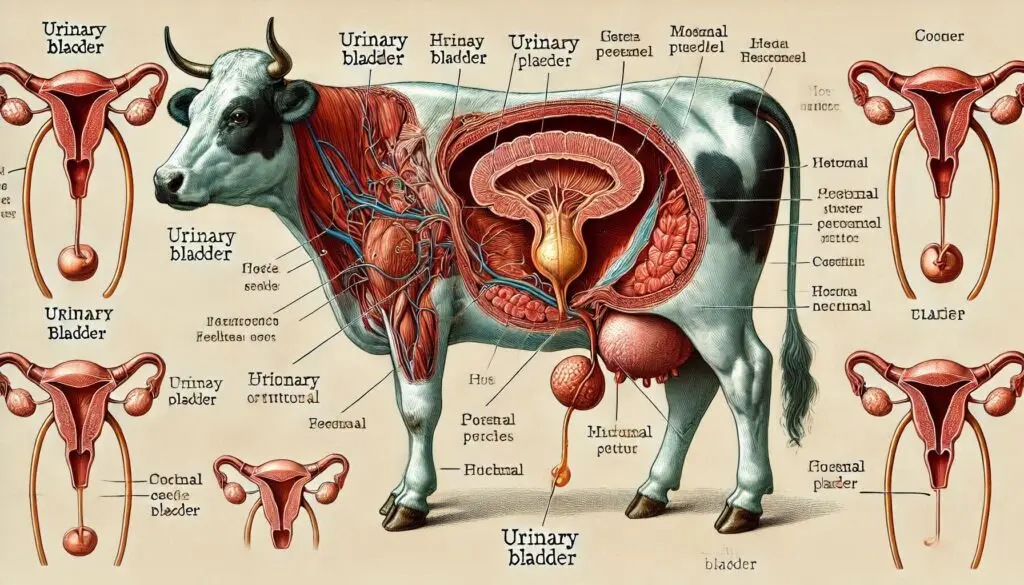Ureters in Livestock

Introduction to Ureters in Livestock
Ureters play a crucial role in the urinary system of livestock. These tubes transport urine from the kidneys to the bladder. Understanding their structure and function is essential for veterinarians and farmers alike. This knowledge helps ensure the health of animals and improves overall farm productivity.
Importance of Ureters
The ureters are vital for maintaining fluid balance and excreting waste. They help prevent urinary tract infections and other complications. In livestock, any issues with the ureters can lead to serious health problems. Therefore, recognizing potential anomalies is critical.
Anatomy of Ureters
Structure and Location
In livestock species such as cattle, sheep, pigs, and goats, ureters are muscular tubes that connect the kidneys to the bladder. Each ureter is approximately 1.5 to 6 mm in diameter. The length varies depending on the species.
Ureter Composition
The ureters consist of three layers:
- Mucosa: This innermost layer is lined with transitional epithelium.
- Muscularis: This middle layer contains smooth muscle that helps propel urine.
- Adventitia: The outer layer provides structural support.
Variations Among Species
Different livestock species exhibit variations in ureter anatomy. For instance, cattle have longer ureters compared to sheep. These differences can affect surgical approaches and treatment options. For more details on anatomical differences among species, you can refer to Veterinary Anatomy.
Function of Ureters
Ureters serve several key functions:
- Urine Transport: They carry urine from the renal pelvis to the bladder through peristaltic contractions.
- Preventing Backflow: The entrance of each ureter into the bladder creates a one-way valve that prevents urine from flowing back into the kidneys.
- Maintaining Pressure: The muscular walls help maintain pressure within the urinary system.
Understanding these functions is vital for diagnosing urinary issues in livestock.
Common Ureteral Anomalies
While anomalies are rare in livestock compared to pets, they can still occur. Here are some common conditions:
Ectopic Ureters
Ectopic ureters occur when one or both ureters open at an abnormal site rather than into the bladder. This condition can lead to urinary incontinence and other complications.
Symptoms of Ectopic Ureters
- Frequent urination
- Incontinence
- Urinary tract infections (UTIs)
For more information on ectopic ureters, visit PetMD.
Ureteroceles
A ureterocele is a cystic dilation at the end of a ureter within the bladder. This condition can obstruct urine flow and may require surgical intervention.
Symptoms of Ureteroceles
- Difficulty urinating
- Painful urination
- Frequent UTIs
Learn more about ureteroceles from Merck Veterinary Manual.
Aplasia and Duplication
These conditions refer to:
- Aplasia: The absence of one or both ureters.
- Duplication: The presence of an extra ureter.
Both conditions can lead to significant health issues if not addressed promptly.
Clinical Significance of Ureteral Anomalies
Veterinarians must recognize these anomalies as they can lead to severe complications:
Urinary Tract Infections (UTIs)
Anomalies like ectopic ureters increase the risk of UTIs due to improper urine flow or retention. UTIs can cause discomfort and lead to more serious kidney issues if left untreated.
Hydronephrosis
This condition occurs when urine backs up into the kidneys due to obstruction in the urinary tract. Hydronephrosis can cause kidney damage over time.
Symptoms of Hydronephrosis
- Abdominal pain
- Reduced urine output
- Swelling in the abdomen
For further reading on hydronephrosis, check out VetInfo.
Diagnosis of Ureteral Issues
Diagnosing ureteral problems typically involves several methods:
Physical Examination
A thorough physical exam helps identify any signs of distress or abnormalities.
Imaging Techniques
Veterinarians often use imaging techniques such as:
- Ultrasound: This non-invasive method visualizes kidney and urinary tract structures.
- Radiography: X-rays can help identify obstructions or abnormalities.
For more detailed imaging techniques used in veterinary practice, refer to Veterinary Radiology.
Laboratory Tests
Urinalysis can detect infections or abnormalities in urine composition. Blood tests may also be conducted to assess kidney function.
Treatment Options for Ureteral Anomalies
Treatment depends on the specific anomaly and its severity:
Surgical Intervention
In cases like ectopic ureters or ureteroceles, surgery may be necessary to correct the issue. Surgical options include:
- Reimplantation of ectopic ureters.
- Removal of obstructed segments.
Medical Management
For less severe cases or when surgery is not an option, medical management may involve:
- Antibiotics for UTIs.
- Pain management medications.
Consulting with a veterinarian is crucial for determining the best treatment plan.
Preventive Measures for Urinary Health in Livestock
Maintaining urinary health is vital for livestock well-being:
Regular Veterinary Check-ups
Routine check-ups help catch any potential issues early on. Regular examinations should include:
- Urinalysis
- Blood tests
Proper Nutrition
A balanced diet supports overall health and proper kidney function. Ensure your livestock receives adequate hydration and nutrients.
Monitoring Behavior
Keep an eye on your animals’ urination habits. Any changes could indicate underlying issues that need attention.
Conclusion
Understanding the anatomy and function of ureters in livestock is essential for maintaining their health. Recognizing potential anomalies allows for timely intervention and treatment.
More from Veterinary Anatomy:
Cell Organelles






Responses